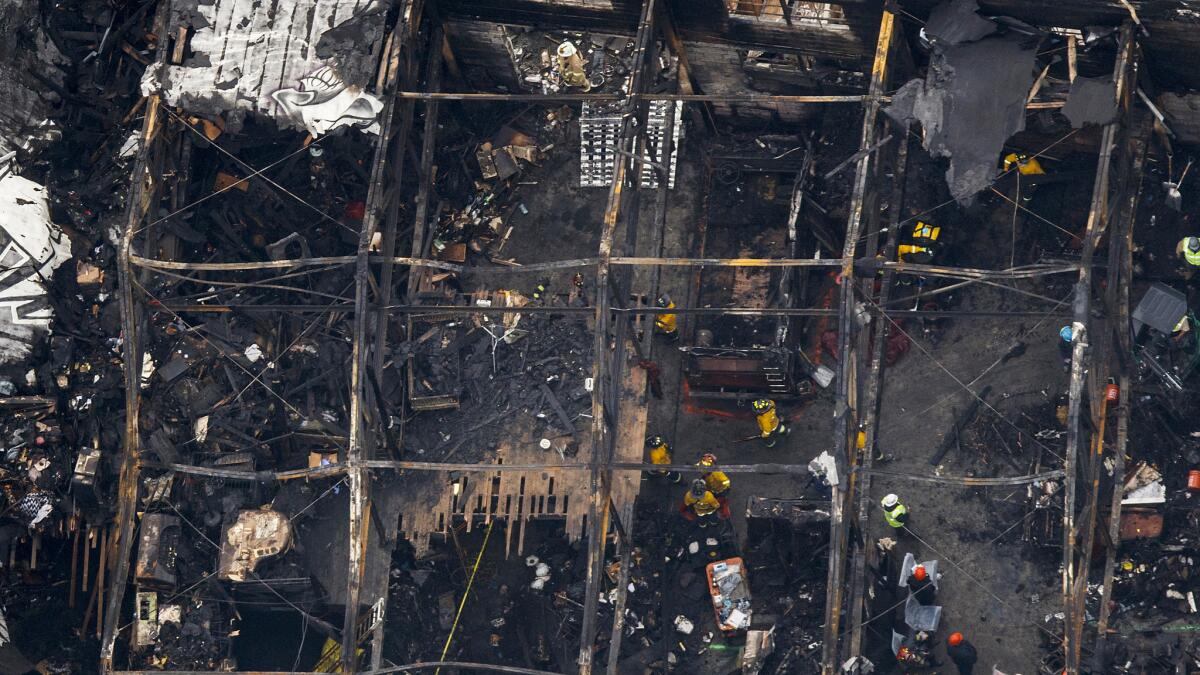Ghost Ship founder testifies at manslaughter trial: ‘You can’t put into words how I feel’

With his head bowed and his voice quivering, the man who founded the Oakland art installation that turned into the site of one of the deadliest blazes in California history took the stand in his manslaughter trial Monday, expressed remorse and appeared crestfallen as relatives of those who died in the Ghost Ship warehouse fire looked on.
Derick Almena, 49, said he felt responsible for the 36 men and women who died when a fire erupted during an electronic dance concert inside the warehouse in December 2016, but also spent much of his first day of testimony shifting blame for the conditions inside the building to the property’s landlord.
“You can’t put into words how I feel,” Almena said after his attorney asked him if he felt some “sentiment” for the dead. “You can’t judge my heart.”
Almena and 29-year-old Max Harris, the Ghost Ship’s self-described “creative director,” each face 36 counts of involuntary manslaughter. Almena and Harris pleaded no contest to the charges last year, and were set to spend nine and six years in prison, respectively. But Alameda County Superior Court Judge James Cramer rejected the pleas after several of the victims’ relatives made impassioned pleas against the deal. Cramer also said Almena had not shown enough remorse for the deaths.
Remorse was at the heart of Almena’s testimony Monday. Wearing a black suit with his hair tied back in a knot, the Los Angeles native sighed heavily and slumped when his attorney, J. Tony Serra, asked him how and why he was responsible for the deadly fire.
“I instigated something. I built something. I dreamed something,” he said of his creation of the Ghost Ship.
He told the court he had been placed on suicide watch and gained at least 60 pounds while jailed for the last two years.
Prosecutors have long argued that Almena and Harris morphed the warehouse into a tinderbox with almost no practical means of escape.
The building was filled from “floor to ceiling” with tapestries, pianos and furniture, according to prosecutors, who said Almena and Harris failed to place smoke alarms or fire suppression systems inside the structure. The two repeatedly lied about having converted the industrial property into a rental space attractive for artists desperate for relief in the Bay Area’s out-of-control housing market, prosecutors said.
On Dec. 2, 2016, nearly 100 people piled into the warehouse for a concert. According to a criminal complaint, Harris blocked off a stairwell that served as a secondary exit. But when the blaze erupted and converted the various art projects into kindling, concertgoers and residents had only one way out — a narrow, rickety staircase.
Coroner’s officials determined each victim died of smoke inhalation.
“They died because they had no notice, no time and no exits,” Alameda County Assistant Dist. Atty. Casey Bates said during opening statements in April.
Almena’s testimony may last all week, Serra said. He spent much of Monday highlighting Almena’s background as a photographer and self-described minister to at-risk youth. Almena told the downtown Oakland courtroom that he created the Ghost Ship as an attempt to provide a public service to the city’s artist community. Gatherings at the Ghost Ship were “necessary current events … the lifeblood of our community,” he said.
In the gallery, those whose children and loved ones died in the fire scoffed at Almena’s testimony. Some rolled their eyes as Serra displayed photographs taken earlier in Almena’s arts career.
David Gregory, whose daughter Michela died in the blaze, said he was extremely skeptical of Almena’s emotional displays.
“I just don’t believe him,” Gregory, who has attended every moment of the trial, said outside the courtroom.
Although Almena’s testimony officially began Monday, he has spoken out several times since the deadly blaze.
Days after the fire, Almena gave a bizarre rambling interview to NBC’s “Today Show” in which he apologized for the tragedy while shouting down questions. In a jailhouse interview with Oakland’s Fox affiliate KTVU in 2017, Almena repeatedly pushed back on the perception that he was responsible for the dangerous conditions inside the Ghost Ship, deflecting blame toward the building’s owner Chor Ng.
Ng has never been charged and has repeatedly declined to comment. She has been named in numerous negligence lawsuits brought by relatives of the victims. In court Monday, Almena said Ng “tricked” him into leasing a property without proper plumbing or electricity and said he did his best to make the warehouse function despite her repeated refusals to fund improvements to the building.
Fire officials were never able to determine a cause of the blaze, a point Almena’s defense attorneys have repeatedly seized on.
Serra has previously argued that the fatal blaze may have been set by arsonists who lobbed Molotov cocktails at the building. He raised the point again Monday while questioning Darold Leite, the Ghost Ship’s self-described “maintenance man,” who testified he saw a group of people running from the building shortly after the fire.
Bates quickly picked apart Leite’s testimony, saying Leite had no idea if the group he saw running were residents or concertgoers fleeing the blaze.
Almena said Monday that he did not believe the building was a fire risk, noting that he had lived there with his wife and three children.
“I believed it was safe,” he said. “I was told it was safe.”
The Associated Press contributed to this report.
Follow @JamesQueallyLAT for crime and police news in California.
More to Read
Sign up for Essential California
The most important California stories and recommendations in your inbox every morning.
You may occasionally receive promotional content from the Los Angeles Times.











